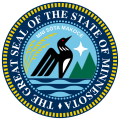October 13, 1857 | |||||||||||||||||
| |||||||||||||||||
 County results
Contents | |||||||||||||||||
| |||||||||||||||||
The 1857 Minnesota gubernatorial election was held on October 13, 1857, to elect the inaugural governor of Minnesota. A Democrat would not be elected governor of Minnesota again until 1898.
October 13, 1857 | |||||||||||||||||
| |||||||||||||||||
 County results
Contents | |||||||||||||||||
| |||||||||||||||||
The 1857 Minnesota gubernatorial election was held on October 13, 1857, to elect the inaugural governor of Minnesota. A Democrat would not be elected governor of Minnesota again until 1898.
| Party | Candidate | Votes | % | |
|---|---|---|---|---|
| Democratic | Henry Hastings Sibley | 17,790 | 50.34 | |
| Republican | Alexander Ramsey | 17,550 | 49.66 | |
| Total votes | 35,340 | 100 | ||
| |||||||||||||||||||||||||||
| |||||||||||||||||||||||||||
| |||||||||||||||||||||||||||
| |||||||||||||||||||||||||||
| | This Minnesota elections-related article is a stub. You can help Wikipedia by expanding it. |


